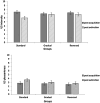The effect of gradual extinction training on the renewal of electrodermal conditional responses
- PMID: 39282984
- PMCID: PMC11579229
- DOI: 10.1111/psyp.14681
The effect of gradual extinction training on the renewal of electrodermal conditional responses
Abstract
Extinction, the repeated presentation of a conditional stimulus (CS) without the unconditional stimulus (US), is the standard paradigm to reduce conditional responding acquired by the repeated pairing of CS and US in acquisition. However, this reduction of conditional responding is prone to relapse. In rodent fear-conditioning, gradual extinction, the fading out of CS-US pairings during extinction, has been shown to reduce the return of fear. The current study replicated the gradual extinction procedure in human fear conditioning and assessed whether it reduced the return of fear due to ABA renewal and reacquisition. During extinction, one group received standard extinction, a second received gradual extinction (increasing the spacing of USs presented after the 1st, 3rd, 6th, 10th, and 15th CS+ trials), and a third received reversed extinction training (decreasing the spacing of USs presented after the 1st, 6th, 10th, 13th, and 15th CS+ trials). Larger renewal and faster reacquisition of differential electrodermal responses to CS+ and CS- were expected after standard and reversed extinction than after gradual extinction training. The results were inconclusive due to the failure to find extinction of differential electrodermal responses and US expectancy ratings in both gradual and reversed extinction groups. Despite successful extinction in group standard, renewal was only observed in US expectancy. Visualization of US expectancy ratings during extinction suggested that potential identification of the US presentation patterns during extinction in the gradual and reversed groups delayed extinction learning.
Keywords: electrodermal responses; fear conditioning; gradual extinction; renewal; return of fear.
© 2024 The Author(s). Psychophysiology published by Wiley Periodicals LLC on behalf of Society for Psychophysiological Research.
Conflict of interest statement
Authors have no conflict of interest.
Figures






Similar articles
-
Presentation of unpaired unconditional stimuli during extinction reduces renewal of conditional fear and slows re-acquisition.Psychophysiology. 2021 Oct;58(10):e13899. doi: 10.1111/psyp.13899. Epub 2021 Jul 6. Psychophysiology. 2021. PMID: 34231228
-
Signalling unpaired unconditional stimuli during extinction does not impair their effect to reduce renewal of conditional fear.Int J Psychophysiol. 2024 Oct;204:112425. doi: 10.1016/j.ijpsycho.2024.112425. Epub 2024 Aug 27. Int J Psychophysiol. 2024. PMID: 39182762
-
The renewal reducing effect of unpaired unconditional stimuli presented during extinction is not specific to the unconditional stimulus used during acquisition.Behav Res Ther. 2025 Feb;185:104675. doi: 10.1016/j.brat.2024.104675. Epub 2024 Dec 17. Behav Res Ther. 2025. PMID: 39721207
-
Novel approaches for strengthening human fear extinction: The roles of novelty, additional USs, and additional GSs.Behav Res Ther. 2020 Jan;124:103529. doi: 10.1016/j.brat.2019.103529. Epub 2019 Dec 5. Behav Res Ther. 2020. PMID: 31865236 Review.
-
Extinction of negative conditioned stimulus valence in human fear conditioning.Behav Res Ther. 2024 Mar;174:104477. doi: 10.1016/j.brat.2024.104477. Epub 2024 Jan 9. Behav Res Ther. 2024. PMID: 38281443
References
-
- Angold, A. , Costello, E. J. , Messer, S. C. , & Pickles, A. (1995). Development of a short questionnaire for use in epidemiological studies of depression in children and adolescents. International Journal of Methods in Psychiatric Research, 5(4), 237–249.
-
- Australian Institute of Health and Welfare . (2021). Australian Burden of Disease Study: Impact and causes of illness and death in Australia 2018. https://www.aihw.gov.au/getmedia/5ef18dc9‐414f‐4899‐bb35‐08e239417694/ai...
MeSH terms
Grants and funding
LinkOut - more resources
Full Text Sources

